Louis Ashbourne Serkis The Kid Who Would Be King
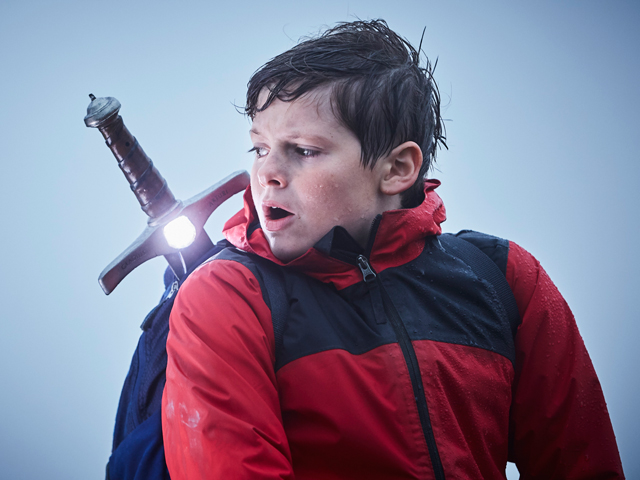
Old School Magic Meets The Modern World.
Cast: Rebecca Ferguson, Patrick Stewart, Tom Taylor, Louis Ashbourne Serkis
Director: Joe Cornish
Genre: Action, Adventure
Rated: PG
Running Time: 120 minutes
Synopsis: Old school magic meets the modern world in the epic adventure The Kid Who Would Be King. Alex thinks he's just another nobody, until he stumbles on the mythical Sword in the Stone, Excalibur. Now, he must unite his friends and enemies into a band of knights and, together with the legendary wizard Merlin, take on the wicked enchantress Morgana. With the future at stake, Alex must become the great leader he never dreamed he could be.
The Kid Who Would Be King
Release Date: January 17th, 2019
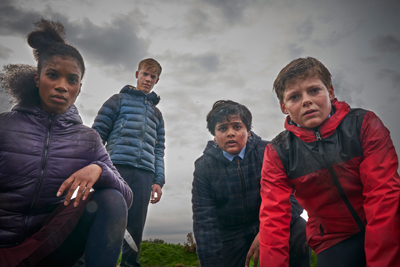 About The Production
About The Production
Based on one of the most famous myths of all time, The Kid Who Would Be King approaches the legend of King Arthur and his knights in a completely new way, bringing it into the modern world and making it relevant for contemporary audiences.
The seed for The Kid Who Would Be King has been growing in the mind of writer-director Joe Cornish since he was a child, beginning in 1982 when he saw John Boorman's 'Excalibur' and Steven Spielberg's 'E.T.' Both films had a big impact on the young Cornish, inspiring the beginnings of his idea for a film about an ordinary boy who discovers The Sword in the Stone.
Cornish recalls, "All through my teenage years I drew a little cartoon on my school books of the sword Excalibur coming out of a bathtub – the juxtaposition of the domestic and the modern with the ancient myth. Then I put the idea aside, but it's slowly been gestating ever since."
Cornish went on to co-write, direct and star in the long-running British comedy series 'The Adam and Joe Show.' He then wrote and directed his first feature 'Attack the Block' which earned multiple international awards, including the Audience Award at South by Southwest Festival and a BAFTA nomination. Shortly after, alongside Edgar Wright, he wrote the story and screenplay for Marvel's 'AntMan' as well as 'The Adventures of Tintin' for Steven Spielberg and Peter Jackson, before eventually returning to his ever-alluring modern-day Sword in the Stone.
Researching for the script, Cornish and producer Nira Park visited schools and asked the pupils how familiar they were with King Arthur and the legend of Excalibur. They found that the children were familiar with the image and idea of Excalibur – that whoever was able to pull the sword from the stone became king – but they were confused about how that fitted in with today's British royal family. Cornish adds "they knew of the sword but not its repercussions, and I thought that was a cool and interesting place to build from."
Cornish continues, "The idea behind this movie is that myths and legends like the story of King Arthur don't have a huge amount of basis in historical fact.
They're written and rewritten to suit the needs of the time, and in fact, it's important that different generations rewrite legends anew for themselves. So when I wrote this script, that was at the forefront of my mind, that I could take what I wanted from existing mythology and use it in the way that I wanted – because that's what Mallory did, that's what French poets did, that's what everybody who followed has done with the Arthurian legend – it's there for all of us to interpret in our own way."
The heart of the film is based on the chivalric code that the wizard Merlin teaches young Arthur in the legend. This is the set of laws that King Arthur's knights abided by, which dictated earnest moral behavior – honoring the people you love, persevering, refraining from offense and telling the truth. In the film, Cornish takes that moral code and applies it to modern kids, to see what its value is in today's world.
He explains, "The kids in this movie go on a journey from being a little bit rough-and-tumble, rude and angry with each other, to a place where they understand the value of that basic moral code and apply it to their modern world. I hope that as well as being an epic action adventure movie full of fun, comedy, and emotion, that there's also a message for kids that explains the value of these ancient ideals, that they might have some relevance to the way we live today."
Cornish's vision for the magic in the film was very clear " he wanted it to feel practical, physical and real-world " as though kids could actually perform it in their own homes. Says the writer-director, "The magic in The Kid Who Would Be King isn't the sort of sparkly, spangly, escapist magic that we're used to seeing in fantasy films. Instead of romanticised ancient spell books and magic wands, our magic is much more physical and practical. When something transforms in our movie you can really feel it. When our Merlin performs magic, it's by intricate combinations of hand movements that create a physical impact on the characters and environment nearby."
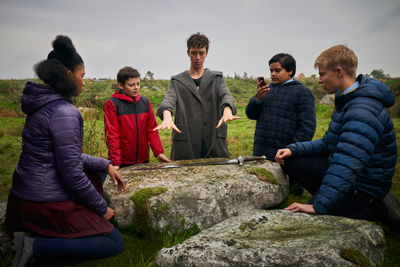 Bringing the Characters to Life
Bringing the Characters to Life
With a script in place, Cornish and Nira Park held auditions all over the UK to find actors to portray the young knights at the heart of the film. Cornish envisioned his lead character of Alex as a modern kid on the cusp of adolescence who – feeling like a nobody – is starting to become a little cynical about the world around him.
Cornish expands on this theme: "I think when you're at that age, you are trying to figure out what the world is and what you have to do to get ahead in it. You start to see a connection between what kind of circumstances you're born into and where you might end up. So, at the beginning of the movie, when Alex gets punished after trying to save his friend from being bullied, he realises that however righteous and noble you try to be, the world can still be unjust."
When he finds the sword in the stone, the books Alex has read about the myth of Excalibur convince him that he's the once and future king. But possessing the sword doesn't actually help him that much. Says Cornish, "It's not as if the government is suddenly going to acknowledge his position, it's not as if there isn't already a royal family. And the immediate obstacle in front of him is to deal with these undead knights that rise up out of the ground and try to take the sword from him. So he's a perfectly normal kid who's suddenly thrust into this massive adventure, while also trying to fill the shoes of King Arthur, who himself found Excalibur when Britain was a lost and leaderless place. Part of the Arthurian legend is that, through drawing the sword, he unites the country and turns enemies into allies."
Finding the right young actor to handle all this was a difficult job. Cornish recalls, "For the role of Alex, we saw loads and loads of kids, and we came down to about two or three. But then Louis Ashbourne Serkis entered the audition process, and he just blew everybody away, because he was so detailed, so unmannered, so natural in the way he performed."
He continues: "He's very cool, Louis. He doesn't flaunt his talent, but when you call action, something magical happens. Even at the first audition, he looked calm and detached, but then as soon as the camera rolled, it just started happening."
Says Ashbourne Serkis about his character, "Alex lives with his mum and she can't really spend that much time with him because she has to work. He's quite disillusioned because his dad's left them, and he and his one friend Bedders get bullied at school. He thinks there's no hope, and life's not going to get any better - he's just another nobody kid. But then obviously when he stumbles across the sword everything changes."
Bedders, Alex's best friend, is based on Sir Bedivere, one of King Arthur's most loyal knights. Bedders is completely devoted to Alex and very earnest. Whereas Alex is full of doubts and quite cynical, Bedders is still very much a kid. He still believes in all the fantasies and legends of childhood fiction, and is desperate for them to be real. When they actually become real, he's both thrilled and terrified.
The writer-director explains, "Bedders is the kid that clings onto childhood when all his friends are turning their backs on that and heading into adulthood. He's the sort of friend you might suddenly find yourself a little bit embarrassed by when you start to enter adolescence. He is vulnerable and sweet, but over the course of the story transforms into a kick-ass hero."
Dean Chaumoo, with no prior acting experience, was cast in the role after delivering an emotional monologue from 'Stand by Me' and reducing everyone in the audition room to tears. "It's exciting and risky to give a very young, inexperienced actor a big part like that," says Cornish.
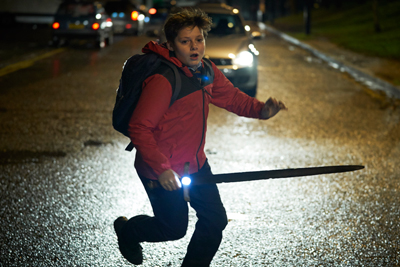 Lance and Kaye, who start out as bullies, are inspired by the legendary Sir Lancelot and Sir Kaye. Cornish says, "In Arthurian legend, Lancelot is quite a confused character. He's this incredibly capable knight, who can't find an adversary worthy of him in battle, until he comes across Arthur. Only then does he find somebody who is worthy of his loyalty. But he ends up betraying Arthur by having an affair with his wife Guinevere and in so doing causes Camelot to disband. Like Lancelot, our Lance is also confused – a combination of loyalty, betrayal, heroism, and dastardliness. He has poise and good looks, but he doesn't know what to do with his power, so he misuses his attributes for evil. He bullies people and is pompous and arrogant, following this bad path all the way through to the middle of the movie, where he realizes how foolish he's been. The presence of the sword and the adventure they're on make him figure out the error of his ways and he ultimately becomes one of Alex's most loyal knights."
Lance and Kaye, who start out as bullies, are inspired by the legendary Sir Lancelot and Sir Kaye. Cornish says, "In Arthurian legend, Lancelot is quite a confused character. He's this incredibly capable knight, who can't find an adversary worthy of him in battle, until he comes across Arthur. Only then does he find somebody who is worthy of his loyalty. But he ends up betraying Arthur by having an affair with his wife Guinevere and in so doing causes Camelot to disband. Like Lancelot, our Lance is also confused – a combination of loyalty, betrayal, heroism, and dastardliness. He has poise and good looks, but he doesn't know what to do with his power, so he misuses his attributes for evil. He bullies people and is pompous and arrogant, following this bad path all the way through to the middle of the movie, where he realizes how foolish he's been. The presence of the sword and the adventure they're on make him figure out the error of his ways and he ultimately becomes one of Alex's most loyal knights."
To portray Lance, the filmmakers needed to find a young actor capable of embodying a multi-layered character full of contradictions.
Recalls Cornish, "Tom Taylor was really interesting in his audition, because he's very handsome, but he's also very goofy. He's got this kind of awkwardness and silliness about him. Even though he looks very striking and poised, he can be awkward and self-conscious. So, he brought a cool, comic energy to what might otherwise have been a more straightforward bully."
Taylor found qualities in Lance he could relate to. He says, "At the beginning of the film he's a bully, but there are reasons why. His parents are absent and just send him money. That's how his parents have always shown their love to him, so at school he just goes around bullying kids for money because that's the only way he knows how to feel like anything."
Like the Sir Kaye of legend, Cornish fashioned his Kaye as someone who is arrogant and haughty but also sycophantic. Beholden to Lance, she is afraid to assert her intelligence and become independent in her own right.
Says Cornish, "Kaye is a clever girl, who doesn't really get the chance to express that until later in the story when she realises that Lance has drawn them both down this dead-end path. So, she emerges as somebody who is using her talents for bad purposes, realizes the error of her ways, and becomes an extremely capable, brave, and loyal knight by the end of the movie."
Kaye required an actress who could express strength and vulnerability as well as a forceful personality through her performance. The writer-director says, "Rhianna Dorris is a really talented young actress. She has an incredible presence, very self-assured and confident, and even when she doesn't say anything, she has this very strong connection with the camera."
Dorris explains, "Kaye was this strong female, very blunt and straightforward, but really she's just a normal teenage girl. She doesn't really care about what you have to say in a conversation, she just says what she says, and walks away. She has her cheeky moments, and she's got a lot of attitude."
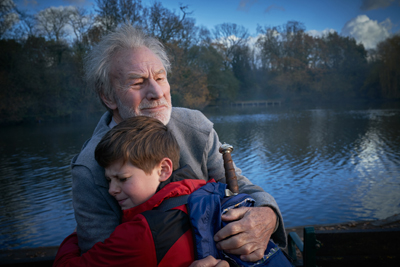 Arthur's teacher, the wizard Merlin, is among the most famous characters in literature and the prototype for many characters in popular culture, including ObiWan Kenobi as well as Dumbledore and Gandalf. Like the legendary Merlin, the film's Merlin is a combination of energies " he's incredibly wise and mystical but also playful and a little bit subversive, capable of lying, manipulating and tricking you.
Arthur's teacher, the wizard Merlin, is among the most famous characters in literature and the prototype for many characters in popular culture, including ObiWan Kenobi as well as Dumbledore and Gandalf. Like the legendary Merlin, the film's Merlin is a combination of energies " he's incredibly wise and mystical but also playful and a little bit subversive, capable of lying, manipulating and tricking you.
Merlin has been represented on screen many times, and as Cornish explains: "We wanted to do something different with him, and one of the interesting elements in the myth is the fact that he lives backwards in time. That has been interpreted in different ways, but the way I wanted to approach it was literal – that the older he becomes, the younger he physically is."
To that end, two actors were needed to play Merlin in The Kid Who Would Be King, one to portray him as a young wizard and another when he's older. Cornish elaborates: "If Merlin wants to really ram a point home, or have authority around the kids, he transforms into his older self, where he has real gravitas. In his old incarnation, he has authority that he doesn't necessarily have in his younger form."
He adds, "Adult Merlin is a very important character in the movie, because he has to have real presence and charisma. He appears in moments of great crisis, when the kids need to be inspired, frightened, or emboldened by the presence of an authoritative, grown-up wizard.
We knew we wanted somebody with all those qualities, and one of our very first thoughts was Sir Patrick Stewart. We're used to seeing him play very wise characters, but we've never seen him as this sort of slightly flea-bitten, down at heel, scruffy looking wizard. When I first met Sir Patrick to talk to him about the part, I told him that this was a very different incarnation of Merlin, that this was a character that arrives in the world naked, who acquires a hodgepodge of clothes, someone you would perhaps mistake for a homeless person or a tramp if you saw him without knowing who he was. He immediately found the idea very appealing.
When Sir Patrick turned up on the set, it was an absolute thrill. And because of who he is, he brought all those energies that the script requires. The look on our young actors' faces when they were in a scene with him had all the sort of adulation and respect and excitement that you need for the narrative, without having to act it. It just happened naturally."
He continues, "The other cool thing about Sir Patrick is, of course, he's in John Boorman's 'Excalibur,' which is, for me, the ultimate Excalibur movie. He plays Sir Leondegrance who's one of the knights that tries and fails to first pull the sword from the stone before young Arthur succeeds. So it was very cool for that to come full circle."
Stewart recalls, "When I was sent the script, I was immediately intrigued by the whole notion of transferring what is usually looked on as a medieval piece, into modern day, and that the great legendary heroes of the Arthurian stories were children, who are tasked by the young Merlin to take over and challenge the powers of darkness, which are threatening to wreck the United Kingdom."
For the veteran actor, the morality and humanity of the mythology is very powerful. He explains that the legend of King Arthur is "high romance, in the historic sense of romance. There is one of the world's great love stories, that of Guinevere and Arthur, and Guinevere and Sir Lancelot. I think I was drawn to Mallory's book for the same reason that I was drawn to Shakespeare when I was a teenager. The language was so vivid and unusual, and yet very characteristic of the period he was writing about. That, and the whole philosophy of how the power of good can triumph over evil. How in the world – and this is in Mallory – you have to be on the lookout for those people or creatures who seek to destroy all that is good. The morality of these stories have always had a strong impact on me. Also, even though they are probably somewhat larger than life heroic figures, there is a great and detailed humanity about them."
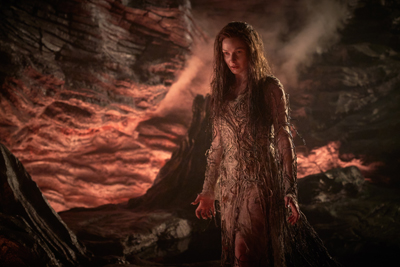 Stewart continues, "One of the big attractions of this project was that I would be working with another actor who was playing the same role, which I don't think I've ever done before. I was fascinated with that, so early on I did some work with Angus. We met, and we had a few little experiments that we tried. We both found a passage of Shakespeare that we knew by heart, and so we spoke it in unison, with each one of us trying to imitate the other's voice. I'd never done anything like that before, and it was a fascinating exercise."
Stewart continues, "One of the big attractions of this project was that I would be working with another actor who was playing the same role, which I don't think I've ever done before. I was fascinated with that, so early on I did some work with Angus. We met, and we had a few little experiments that we tried. We both found a passage of Shakespeare that we knew by heart, and so we spoke it in unison, with each one of us trying to imitate the other's voice. I'd never done anything like that before, and it was a fascinating exercise."
The filmmakers found their young Merlin, Angus Imrie, through the audition process. Says Cornish, "Angus is incredibly talented and really charismatic, and he inhabits this part brilliantly. To play this incredibly wise, clever, old character at the age of 22, means that you have to have those same qualities just behind your eyes so that when you perform the scene, we really believe it. Angus put a massive amount of work into the role and has that authentic charisma and authority that the character needs."
Before filming started, Imrie decided to complete the 20-mile walk that the young knights undertake in the movie, from Bodmin Moor to Tintagel. He camped alone on the moor overnight so that he could start walking as soon as the sun came up. He spent all day walking without a map and finally arrived in Tintagel, where he discovered Merlin's Cave and went for a swim in the sea. Imrie explains "I wanted to get a sense of the landscape, because it's so important for Arthurian legend, Tintagel and Cornwall, I think. Funnily enough, when we filmed it, I really sensed this kind of pagan, ancient land."
One of the most vivid characters in the legend is the sorceress Morgana – King Arthur's half-sister and illegitimate offspring of a magical birth. Because she has had her inheritance and the sword taken away from her, she becomes evil, jealous, and covetous of the sword, which she believes is rightfully hers. Morgana is trapped by Arthur and Merlin underground, bound into the bowels of the Earth by magic, where she remains dormant for centuries.
In Cornish's script, goodness is diminishing in the world. People are becoming more selfish, and nations have grown increasingly divided. It is this shift towards darkness, as well as a total solar eclipse, that gives Morgana the strength to break free and return. When she discovers the sword has come back, she immediately wants it, and seeks to destroy whoever has it.
Cornish says, "There's an expectation these days for villains to have terrific complexity, and to be very sympathetic, which sometimes robs them of a certain level of menace that I remember from movies when I was a kid. So I was excited to have a character who has her reasons for being evil, but is essentially a bad person, with these terrifying abilities to shape-shift and transform into other creatures. Also, she thinks she's going to have a very easy time, because she's fighting kids, but doesn't really bargain for the strength and perseverance of the army of young knights that assembles to fight her."
Rebecca Ferguson was shooting on 'Mission Impossible - Fallout' with Simon Pegg – a long-time friend and collaborator of Cornish and Park – who suggested Cornish approach her about playing Morgana. She admits, "I didn't have time to read the script before I met up with Joe at a little café. We sat down, and he went through the entire script for an hour-and-a-half, mimicking, doing all the voices for all the characters, sometimes standing up and portraying the entire film, and finally I looked at him and said, 'I haven't read the script. You have me.' Literally, I signed onto it there and then, with no contract and having not read the script." She continues: "Joe has been working on this story for so many years – it's been his dream project, which means he is burning with desire every time he talks about it."
Cornish was delighted that Ferguson was attracted to the role. "We were very lucky that Rebecca really responded to the material and was excited to play this larger than life role that involved her putting on elaborate prosthetics and transforming into these crazy creatures – breathing fire and flying, and fighting an army of kids. I think she really relished and enjoyed the experience, taking it very seriously and working incredibly hard on her physical movement. She gave us a huge amount of time and energy, above and beyond the call of duty, and has a phenomenal presence and charisma in the movie. I think she's pretty scary."
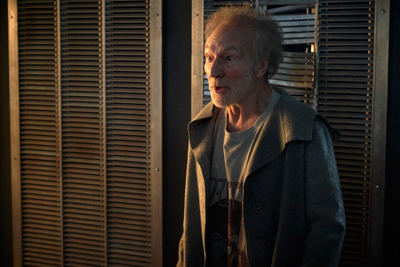 Achieving the Look of the Characters and the Film
Achieving the Look of the Characters and the Film
Cornish was very specific about how each of the characters in The Kid Who Would Be King should look and wanted his young knights to be grounded in reality. For that reason, he enlisted the services of Jany Temime, who designed the costumes for six of the Harry Potter films. Temime chose medieval colors, like dark red and blue for the knights' school uniforms and silver for their armor, blending 12th century form with contemporary designs. For Young Merlin, who arrives naked into the world, she had to create a costume made up of items he has had to pick up along the way, from a Led Zeppelin t-shirt and too-short trousers that he takes from a school boy, to yellow booties and a long coat that he nabs from a chicken shop. The overall look is modern with a nod to the medieval. Old Merlin wears an identical costume, but one that is aged and colorized differently, with an identical design on his coat to Morgana's dress which establishes a link between the two ancient characters.
Morgana's appearance when she's imprisoned underground was conceived as a combination of prosthetics and special effects to create a unique blend of veins and vines across her body, with a pre-Raphaelite, translucent feel. When she separates herself from the subterranean tree, the roots and vines magically curl to create a dress, which is wet and dirty yet beautiful – a kind of haute couture piece of art.
Says Temime, "Morgana has to cut herself free. So, I started doing some embroidery onto tulle and then little by little we found a way to give the effect of roots. Then we added some slick, grimy pieces of root onto her costume, and immediately it became more realistic and less pretty, less romantic. It was still very beautiful, but it had something tragic and a little bit disgusting, which helped for the character very much."
Ferguson adds, "It's a three-hour ritual every morning, and it's just incredible seeing Morgana take shape. We have all this incredibly intricate tattoo work, that's supposed to look like oozing tidal veins being pumped and soaked within my body."
Morgana's long-dead medieval henchmen, the Mortes Milles, are brought back to life with lava in their veins. Although they were achieved through visual effects, Cornish wanted to make the experience as real as possible for the cast members interacting with them. So stunt performers were dressed in illuminated suits and given light-up swords which cast fiery light on the real environments. When they were on horseback, they rode real steeds in order to provide the effects team with the correct physicality and presence in the space, while offering a feel of authenticity for the actors to perform against.
Whil there have been many films which explore Arthurian legend, Rebecca Ferguson says, "I had never seen the story of Arthur as a modern piece, with upto-date young kids in hoodies and sneakers, with modern, makeshift armor on top of it. It's a fantastic mixture of old and new, clashing and complimenting in a way which is lovely."
Location Manager Jason Wheeler explains, "Joe has had the formations of the characters and the ideas for the look in his head since he was a teenager. And the more time I spent with Joe and Marcus [Rowland, Production Designer], talking about ideas, locations, design, and the look of the film, the more nuggets came from him, because they've been in his mind for so long. It was exciting to make the movie of someone who, as a young boy, imagined these characters and these scenarios, from a legend that we're all familiar with, and to help him interpret that."
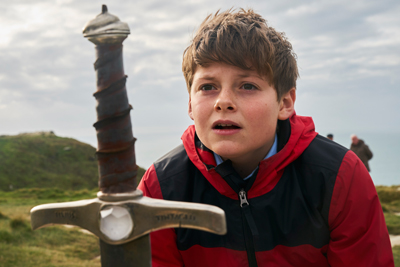 Adds Rowland, who worked previously with Cornish on 'Attack the Block,' "Because Joe's lived with this story for quite a long time, he was interested in every detail. It was very obvious when we started exploring locations that he had pictured it in his head already, and we tried to work with the images that he already had.
Adds Rowland, who worked previously with Cornish on 'Attack the Block,' "Because Joe's lived with this story for quite a long time, he was interested in every detail. It was very obvious when we started exploring locations that he had pictured it in his head already, and we tried to work with the images that he already had.
Joe's always had a strong instinct for the way it should look and the way the action should be laid out."
Says Cornish, "There are places in this movie where you just think you're in a real space, and little do you know that it's all been conjured out of thin air by Marcus Rowland. There are so many different environments and textures and moods, and Marcus did it all."
To shoot the film, Cornish felt confident he could entrust his vision with Bill Pope, who served as Director of Photography on 'The Jungle Book,' 'The Matrix' trilogy, and two 'Spider-Man' movies, among many others. He explains: "Bill is incredibly fast and talented. He's so good that I can just forget about him and get on with directing and trust that everything I need will be there, and be beautifully lit."
The Kid Who Would Be King was shot over 17 weeks at Leavesden Studios, Cornwall, Somerset, Surrey, and London, in the winter of 2017-2018. Several sets were built at Leavesden Studios, on the outskirts of London, one of the biggest builds being Morgana's underworld. It took 10 weeks to construct, using timber which was then covered in plaster before specialist sculptors were brought in to add intricate the detail. In terms of the design,
Production Designer Marcus Rowland explains, "The subterranean set was focused on the column of roots and stone from which Morgana emerges, so she was the focus of that environment, and all of it stems from her. We imagined that the cave was carved out by lava, so that's the motivation for having a fluid nature to it. There was a whole structure of rivulets flowing through the cave, so it felt like it was active and dangerous."
Meanwhile, Location Manager Wheeler and his team also had to find a school to film numerous key scenes from the film. After looking at nearly 1,500 schools around the country to find the perfect Dungate Academy, they landed at the Ark Academy in Putney. Its exterior is a classic example of a 1960's design, but inside, it's a contemporary, modern academy school.
It was important to Cornish that the film was grounded firmly within Great Britain and its history. He says, "If you leave the cities in this country, you find yourself quickly stumbling upon an incredible ancient castle or some extraordinary Roman ruin. The whole history of the evolution of culture and society in this country is still present in all these places."
Among the many historic locations where they filmed were Bodmin Moor, in the village of Minions, The Hurlers Stones, Dozmary Pool, Tintagel Castle, and Tintagel town, Cornwall.
While much of the action set in Dozmary Pool was created on a set at Leavesden, Cornish was beguiled by the actual location.
He explains, "Dozmary Pool is located on Bodmin Moor, and it is one of the places which the Lady of the Lake is said to have inhabited. It's unusually high above sea level for there to be a body of water. It's neither a pond, nor a lake, but it sits in the middle of the grass as if it's been plonked there. You can really imagine a hand with a sword coming out of it. The first time I visited, there was a very heavy mist. You couldn't see the edges of the lake, so you couldn't tell how big it was, or how deep, and it had this ethereal atmosphere. That really struck me, and we recreated that in the film."
Cornish was also very excited to film on Glastonbury Tor, which he describes as: "An incredibly cinematic, beautiful, man-made hill – part burial mound and part who knows what – with these crazy, beautiful contours, that has an extraordinary history, and is very tied into biblical and Arthurian mythology. There's a whole culture of mysticism and exoticism based around it but hasn't really been seen in a movie before now."
Release Date: January 17th, 2019
MORE



